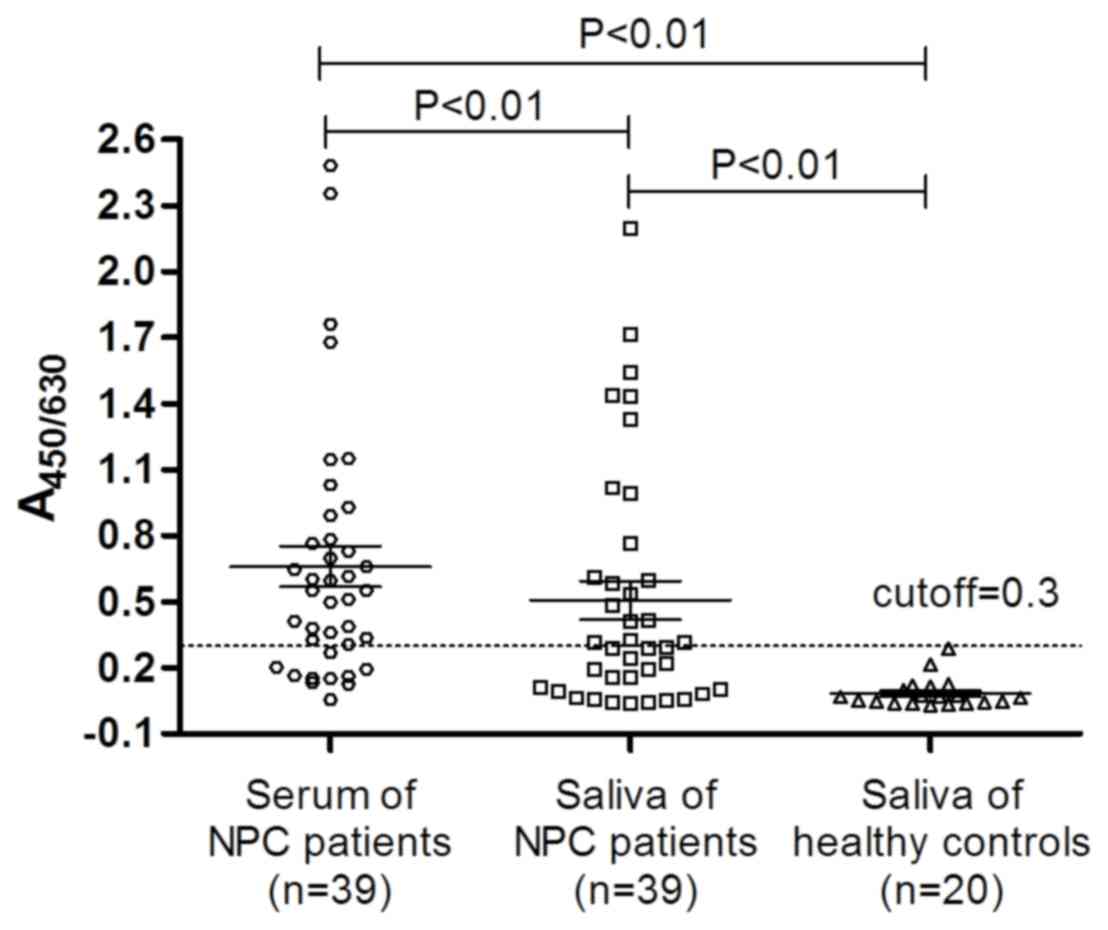|
1
|
Chen JN, Ding YG, Feng ZY, Li HG, He D, Du
H, Wu B and Shao CK: Association of distinctive Epstein-Barr virus
variants with gastric carcinoma in Guangzhou, southern China. J Med
Virol. 82:658–667. 2010. View Article : Google Scholar : PubMed/NCBI
|
|
2
|
Deng Z, Hasegawa M, Matayoshi S, Kiyuna A,
Yamashita Y, Maeda H and Suzuki M: Prevalence and clinical features
of human papillomavirus in head and neck squamous cell carcinoma in
Okinawa, southern Japan. Eur Arch Otorhinolaryngol. 268:1625–1631.
2011. View Article : Google Scholar : PubMed/NCBI
|
|
3
|
Garandawa HI, Ahmad BM and Nggada HA:
Nasopharyngeal cancer in North-Eastern Nigeria: Clinical trends.
Niger J Clin Pract. 12:379–382. 2009.PubMed/NCBI
|
|
4
|
Popat SR, Liavaag PG, Morton R, McIvor N,
Irish JC and Freeman JL: Epstein Barr virus genome in
nasopharyngeal carcinomas from New Zealand. Head Neck. 22:505–508.
2000. View Article : Google Scholar : PubMed/NCBI
|
|
5
|
Rathaur RG, Chitale AR and Banerjee K:
Epstein-Barr virus in nasopharyngeal carcinoma in Indian patients.
Indian J Cancer. 36:80–90. 1999.PubMed/NCBI
|
|
6
|
Valencia SM and Hutt-Fletcher LM:
Important but differential roles for actin in trafficking of
Epstein-Barr virus in B cells and epithelial cells. J Virol.
86:2–10. 2012. View Article : Google Scholar : PubMed/NCBI
|
|
7
|
Shannon-Lowe C, Adland E, Bell AI,
Delecluse HJ, Rickinson AB and Rowe M: Features distinguishing
Epstein-Barr virus infections of epithelial cells and B cells:
Viral genome expression, genome maintenance and genome
amplification. J Virol. 83:7749–7760. 2009. View Article : Google Scholar : PubMed/NCBI
|
|
8
|
Gaur N, Gandhi J, Robertson ES, Verma SC
and Kaul R: Epstein-Barr virus latent antigens EBNA3C and EBNA1
modulate epithelial to mesenchymal transition of cancer cells
associated with tumor metastasis. Tumour Biol. 36:3051–3060. 2015.
View Article : Google Scholar : PubMed/NCBI
|
|
9
|
Kang MS and Kieff E: Epstein-Barr virus
latent genes. Exp Mol Med. 47:e1312015. View Article : Google Scholar : PubMed/NCBI
|
|
10
|
Palser AL, Grayson NE, White RE, Corton C,
Correia S, Ba Abdullah MM, Watson SJ, Cotten M, Arrand JR, Murray
PG, et al: Genome diversity of Epstein-Barr virus from multiple
tumor types and normal infection. J Virol. 89:5222–5237. 2015.
View Article : Google Scholar : PubMed/NCBI
|
|
11
|
Tierney RJ, Shannon-Lowe CD, Fitzsimmons
L, Bell AI and Rowe M: Unexpected patterns of Epstein-Barr virus
transcription revealed by a high throughput PCR array for absolute
quantification of viral mRNA. Virology. 474:117–130. 2015.
View Article : Google Scholar : PubMed/NCBI
|
|
12
|
Foong YT, Cheng HM, Sam CK, Dillner J,
Hinderer W and Prasad U: Serum and salivary IgA antibodies against
a defined epitope of the Epstein-Barr virus nuclear antigen (EBNA)
are elevated in nasopharyngeal carcinoma. Int J Cancer.
45:1061–1064. 1990. View Article : Google Scholar : PubMed/NCBI
|
|
13
|
Finger PT: 7th Edition, AJCC-UICC
Ophthalmic Oncology Task Force: The 7th edition AJCC staging system
for eye cancer: An international language for ophthalmic oncology.
Arch Pathol Lab Med. 133:1197–1198. 2009.PubMed/NCBI
|
|
14
|
Cheng HM, Foong YT, Sam CK, Prasad U and
Dillner J: Epstein-Barr virus nuclear antigen 1 linear epitopes
that are reactive with immunoglobulin A (IgA) or IgG in sera from
nasopharyngeal carcinoma patients or from healthy donors. J Clin
Microbiol. 29:2180–2186. 1991.PubMed/NCBI
|
|
15
|
Tedeschi R, Pin E, Martorelli D, Bidoli E,
Marus A, Pratesi C, Bortolin MT, Zanussi S, Vaccher E, Dolcetti R
and De Paoli P: Serum antibody response to lytic and latent
Epstein-Barr virus antigens in undifferentiated nasopharyngeal
carcinoma patients from an area of nonendemicity. Clin Vaccine
Immunol. 14:435–441. 2007. View Article : Google Scholar : PubMed/NCBI
|
|
16
|
Tang JW, Rohwäder E, Chu IM, Tsang RK,
Steinhagen K, Yeung AC, To KF and Chan PK: Evaluation of
Epstein-Barr virus antigen-based immunoassays for serological
diagnosis of nasopharyngeal carcinoma. J Clin Virol. 40:284–288.
2007. View Article : Google Scholar : PubMed/NCBI
|
|
17
|
Paramita DK, Fachiroh J, Haryana SM and
Middeldorp JM: Evaluation of commercial EBV RecombLine assay for
diagnosis of nasopharyngeal carcinoma. J Clin Virol. 42:343–352.
2008. View Article : Google Scholar : PubMed/NCBI
|
|
18
|
Karray H, Ayadi W, Fki L, Hammami A, Daoud
J, Drira MM, Frikha M, Jlidi R and Middeldorp JM: Comparison of
three different serological techniques for primary diagnosis and
monitoring of nasopharyngeal carcinoma in two age groups from
Tunisia. J Med Virol. 75:593–602. 2005. View Article : Google Scholar : PubMed/NCBI
|
|
19
|
Cho WC: Nasopharyngeal carcinoma:
Molecular biomarker discovery and progress. Mol Cancer. 6:12007.
View Article : Google Scholar : PubMed/NCBI
|
|
20
|
Ai P, Wang T, Zhang H, Wang Y, Song C,
Zhang L, Li Z and Hu H: Determination of antibodies directed at EBV
proteins expressed in both latent and lytic cycles in
nasopharyngeal carcinoma. Oral Oncol. 49:326–331. 2013. View Article : Google Scholar : PubMed/NCBI
|
|
21
|
Yao QY, Rowe M, Morgan AJ, Sam CK, Prasad
U, Dang H, Zeng Y and Rickinson AB: Salivary and serum IgA
antibodies to the Epstein-Barr virus glycoprotein gp340: incidence
and potential for virus neutralization. Int J Cancer. 48:45–50.
1991. View Article : Google Scholar : PubMed/NCBI
|
|
22
|
Nadala EC, Tan TM, Wong HM and Ting RC:
ELISA for the detection of serum and saliva IgA against the BMRFI
gene product of Epstein-Barr virus. J Med Virol. 50:93–96. 1996.
View Article : Google Scholar : PubMed/NCBI
|
















